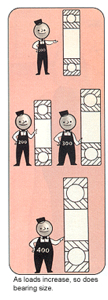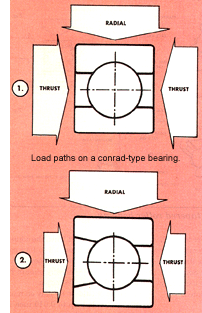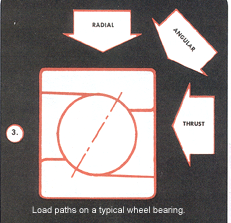On a typical passenger vehicle weighing around 3,400 pounds, each pair of front-wheel bearings, as well as the rear-wheel or axle bearings, supports around 850 pounds, depending on the weight balance and driveline configuration. If it’s a 6,000-pound SUV, each bearing might carry about 1,500 pounds. This load is concentrated on the relatively small bearing surfaces. These loads do not even take into account the dynamic loads produced by cornering.

These loads that are put on the bearing are called thrust and radial loads. These are the forces the bearing must endure when the vehicle is cornering or braking. Another force that can not be measured is the force of impacts from potholes and curbs.
Most serviceable wheel bearings need maintenance every 25,000 to 30,000 miles, or during every brake service. But, the average life of a sealed wheel bearing and hub assembly is about 85,000 to 100,000 miles, without the opportunity for you to repack the bearings. You may only have one chance during a vehicle’s life to replace these parts. If you miss this opportunity, it may be gone forever.
According to a recent Babcox Research survey, 51% of bad wheel bearings are identified and replaced as a result of a customer complaining about noise, 24% are found during a brake job, and 19% are discovered during an alignment.
Why Bearings Fail
The inside of a bearing can be a hot place. When a bearing is cooling off, the contracting metal, air and lubricant can create a vacuum that is hopefully held by the seals. If the seals are worn and can’t hold the vacuum, the bearing or sealed hub unit will suck in outside air, debris and water. In some parts of the country that use salt on the roads, it is almost as bad as ocean water on wheel bearings.
As these contaminants circulate through the grease and between the races and bearings, the components wear and possibly change their metallurgy.
A driver may notice noise coming from the vicinity of the wheel, maybe some steering wander or looseness in the steering, and abnormal tread wear on the front tires. The noise may change when turning, or become louder or even disappear at certain speeds. This noise should not be confused with the clicks and pops produced by a worn outer CV joint on a FWD car. A bad outer CV joint usually only makes noise when turning, not when driving straight ahead.
Once a bearing is worn, the wear rate is accelerated by seals that no longer keep out contaminants, and increased heat may breakdown and eventually expel the lubricants. This is a slippery slope that could quickly lead to catastrophic failure.
Looking Closer
When a bearing wears out, it is usually a case of inadequate lubrication, faulty installation or improper adjustment. For the repair to be successful, you must first determine why the previous bearing failed. For sealed hub units, examining the internal bearings and races is impossible.

Interview the customer to find out what kind of roads they drive on. Also, ask what types of loads they carry. If the customer overloads the vehicle, bearing damage could be inevitable.
The most common failure pattern for bearings is for those on the passenger side of the vehicle to fail first. The passenger side bearings are exposed to the most standing water in the gutter. If the bearings on the driver side of the vehicle fail first, take an extremely close look at the passenger side bearings, failure may not be far behind.
Metallurgy
Most bearing components are heat-treated to harden the metal. But, the heat-treating can only penetrate so far into the metal. Once the bearing has worn through this layer, rapid and catastrophic wear occurs to the softer metal below. This type of fatigue failure is called “spalling.” This kind of damage causes the metal to come off in flakes. If a bearing overheats, the hot lubricant breaks down and can cause scoring and even etching of the bearing surfaces. Also, water and other corrosive elements can create this condition, which leads to spalling down the road. Burned or oxidized lubricant may leave a dark coating on bearing surfaces. Remember that with tapered roller bearings, excessive pre-load can mimic this same damage. If a bearing gets really hot, cages and seals could be deformed and leading to bearing lock-up.
Seals are critical components for the longevity of a bearing. If contaminants from the outside find their way inside, this could cause a wear pattern called bruising. Never re-use seals. Used seals can leak and contaminate brake linings or cause premature bearing failure.
Bearings are precision products that require complex manufacturing processes. Inferior bearings that use low-quality steel and have poor heat-treating can wear and spall prematurely. Also, the poor quality steel may have inclusions of hard or soft metal that can cause a premature failure. In summary, an inexpensive bearing may look the same as a high-quality bearing, but it is what you can’t see that makes a difference between a comeback and a satisfied customer.
Installation
Installing wheel bearings is a relatively straightforward job. But, there are several key items to remember when dealing with serviceable or sealed hub units.
On serviceable bearings, the most important service tip is to invest in a good set of seal drivers. Even a slight distortion in a seal made during installation can shorten the life of the bearing inside. Also, do not skimp on the quality of the grease. Many parts suppliers carry wheel bearing-specific grease that can do an excellent job of protecting the bearings.
Unit hub assemblies combine bearings, seals, hub and spindle in one pre-assembled unit that simply bolts to the suspension. These are “maintenance free” and non-serviceable units that are pre-set, pre-greased and pre-sealed. Some units may require you to install wheel studs. If at all possible, install new wheel studs.
While it may appear to be easier to use an impact wrench, it is not recommended. OEM and bearing manufacturers always recommend using a torque wrench for installation. During removal, an impact wrench can damage the axle nut threads and shock the CV joints. It can also create a false sense of security when adjusting a nut or bolt, which may be under or over torqued. This can leave a hub assembly susceptible to failure. Also, in almost all cases, use a new axle nut. Some axle nuts are designed to be used only once, and can not be adjusted.
Load paths for in a tapered roller bearing: Adjusting
Overtightening adjustable tapered roller bearings is a common error that can lead to premature failure. Tapered roller bearings on the front of RWD vehicles are never preloaded. They’re snugged up with no more than 15 to 20 ft. lbs. of torque while rotating the wheel to make sure the bearings are seated. Then the adjustment nut is loosened 1/6 to 1/4 turn, and locked in place with a new cotter pin. As a rule, endplay should be about 0.001 to 0.005 inches.

There should be no play on most FWD cars, but up to 0.010 inch of play in the front bearings may be acceptable on RWD cars and trucks with adjustable bearings. On FWD cars with adjustable tapered roller rear wheel bearings, the bearing adjustment procedure is usually the same as with RWD vehicles (zero pre-load), but some do require a slight pre-load.













